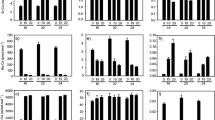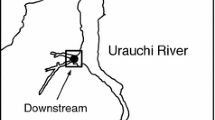Abstract
We tested the hypothesis that strontium:calcium (Sr:Ca) in otoliths are reflective of environmental salinity experienced by two estuarine fishes during early life. Laboratory and field experiments were performed to examine the effects of salinity and temperature on Sr:Ca in otoliths of black drum (Pogonias cromis) and red drum (Sciaenops ocellatus). Otolith Sr:Ca of juveniles reared at four salinities (5‰, 15‰, 25‰, 35‰) differed significantly forP. cromis while no salinity effect was observed forS. ocellatus. Otolith Sr:Ca of both species were not affected by temperature (23°C and 30°C), suggesting that partitioning of Sr in otoliths of these taxa is constant over the temperature range examined. A field verification trial was conducted forP. cromis and a positive relationship between otolith Sr:Ca and ambient salinity was observed, even though the percent variability explained was modest. A series of Sr:Ca point measurements were taken from the core to the edge of the otoliths of wildP. cromis andS. ocellatus, and otolith Sr:Ca chronologies of both species showed conspicuous declines during the first few months of life. While Sr:Ca chronologies of both species suggest that ingress is associated with a reduction in otolith Sr:Ca, inconsistencies in laboratory and field experiments intimate that Sr uptake in the otolith may be insensitive to salinity and regulated by other factors (aqueous chemistry, ontogenetic shifts in habitat, or physiology). Results from early life history transects of otolith Sr:Ca conform to expected patterns of estuarine ingress-egress during early life and indicate that the approach may be useful for detecting large-scale habitat transitions (marine to estuarine habitats).
Similar content being viewed by others
Literature Cited
Able, K. W., D. M. Nemerson, R. Bush, andP. Light. 2001. Spatial variation in Delaware Bay (USA) marsh creek fish assemblages.Estuaries 24:441–452.
Alongi, D. M. 1998. Coastal Ecosystem Processes, CRC Press, LLC, New York.
Arai, T., T. Otake, andK. Tsukamoto. 2000. Timing of metamorphosis and larval segregation of the Atlantic eelsAnguilla rostrata andA. anguilla, as revealed by otolith microstructure and microchemistry.Marine Biology 137:39–45.
Aristizabal, A. E. O. 1992. Effects of salinity and weight on routine metabolism in the juvenile croaker,Micropogonias furnieri (Desmarest 1823).Journal of Fish Biology 40:471–472.
Baltz, D. M., J. W. Fleeger, C. F. Rakocinski, andJ. N. McCall. 1998. Food, density, and microhabitat: Factors affecting growth and recruitment potential of juvenile saltmarsh fishes.Environmental Biology of Fishes 53:89–103.
Bath, G. E., S. R. Thorrold, C. M. Jones, S. E. Campana, J. W. McLaren, andJ. W. H. Lam. 2000. Strontium and barium uptake in aragonitic otoliths of marine fishes.Geochimica et Cosmochimica Acta 64:1705–1714.
Campana, S. E. 1999. Chemistry and composition of fish otoliths: Pathways, mechanisms and applications.Marine Ecology Progress Series 188:263–297.
Comyns, B. H., J. Lyczkowski-Shultz, C. F. Rakocinski, andJ. P. Steen, Jr. 1989. Age and growth of red drum larvae in the northcentral Gulf of Mexico.Transactions of the American Fisheries Society 118:159–167.
de Villiers, S., B. K. Nelson, andA. R. Chivas. 1995. Biological controls on coral Sr:Ca and δ13O reconstructions of sea surface temperatures.Science 269:1247–1249.
de Villiers, S., G. T. Shen, andB. K. Nelson. 1994 The Sr:Ca-temperature relationship in coralline aragonite: Influence of variability in (Sr:Ca) seawater and skeletal growth parameters.Geochimica et Cosmochimica Acta 58:179–208.
Farrell, J. andS. E. Campana. 1996. Regulation of calcium and strontium deposition on the otoliths of juvenile tilapia,Oreochromis niloticus.Comparative Biochemistry and Physiology 115:103–109.
Friedland, K. D., D. G. Reddin, N. Shimizu, R. E. Haas, andA. F. Youngson. 1998. Strontium: calcium ratios in Atlantic salmon (Salmo salar) otoliths and observations on growth and maturation.Canadian Journal of Fisheries and Aquatic Sciences 55:1158–1168.
Geary, B. W., J. R. Rooker, andJ. W. Webb. 2001. Utilization of saltmarsh shorelines by newly settled sciaenids in a Texas estuary.Gulf and Caribbean Research 13:37–49.
Gelwick, F. P., S. Akin, D. A. Arrington, andK. O. Winemiller. 2001. Fish assemblage structure in relation to environmental variation in a Texas Gulf coastal wetland.Estuaries 24:285–296.
Hoff, G. R. andL. A. Fuiman. 1995. Environmentally induced variation in elemental composition of red drum (Sciaenops ocellatus) otoliths.Bulletin of Marine Science 56:578–591.
Kalish, J. M. 1989. Otolith microchemistry: Validation of the effects of physiology, age and environment on otolith composition.Journal of Experimental Marine Biology and Ecology 132:151–178.
Kennedy, B. P., J. D. Blum, C. L. Folt, andK. H. Nislow. 2000. Using natural strontium isotopic signatures as fish markers: Methodology and application.Canadian Journal of Fisheries and Aquatic Sciences 57:2280–2292.
Kimura, R., D. H. Secor, E. D. Houde, andP. M. Piccoli. 2000. Up-estuary dispersal of young-of-the-year bay anchovyAnchoa mitchilli in the Chesapeake Bay: Inferences from microprobe analysis of strontium in otoliths.Marine Ecology Progress Series 208:217–227.
Klein, R. T., K. C. Lohmann, andC. W. Thayer. 1996. Sr/Ca and C-13/C-12 ratios in skeletal calcite ofMytilus trossulus: Covariation with metabolic rate, salinity, and carbon isotopic composition of seawater.Geochimica et Cosmochimica Acta 60:4207–4221.
Lankford, T. E. andT. E. Targett. 1994. Suitability of estuarine nursery zones for juvenile weakfish (Cynoscion regalis): Effects of temperature and salinity on feeding, growth and survival.Marine Biology 119:611–620.
Lea, D. W., T. A. Mashiotta, andH. J. Spero. 1999. Controls on magnesium and strontium uptake in planktonic foraminifera determined by live culturing.Geochimica et Cosmochimica Acta 63:2369–2379.
Ley, J. A., C. C. McIvor, andC. L. Montague. 1999. Fishes in mangrove prop-root habitats of northeastern Florida Bay: Distinct assemblages across an estuarine gradient.Estuarine, Coastal and Shelf Science 48:701–723.
Limburg, K. E. 1995. Otolith strontium traces environmental history of subyearling American shadAlosa sapidissima.Marine Ecology Progress Series 119:25–35.
Milton, D. A. andS. R. Chenery. 2001. Sources and uptake of trace metals in otoliths of juvenile barramundi (Lates calcarifer).Journal of Experimental Marine Biology and Ecology 264:47–65.
Peters, K. M. andR. H. McMichael, Jr. 1987. Early life history of red drum,Sciaenops ocellatus (Pisces: Sciaenidae), in Tampa Bay, Florida.Estuaries 10:92–107.
Peters, K. M. andR. H. McMichael, Jr. 1990. Early life history of black drumPogonias cromis (Pisces: Sciaenidae) in Tampa Bay, Florida.Northeast Gulf Science 11:39–58.
Peterson, M. S., B. H. Comyns, J. R. Hendon, P. J. Bond, andG. A. Duff. 2000. Habitat use by early life history stages of fishes and crustaceans along a changing estuarine landscape: Differences between natural and altered shoreline sites.Wetland Ecology 8:209–219.
Price, W. W. andR. A. Schlueter. 1985. Fishes of the littoral zone of McKay Bay, Tampa Bay System, Florida.Florida Scientist 48:83–96.
Radtke, R. L. 1989. Strontium-calcium concentration ratios in fish otoliths as environmental indicators.Comparative Biochemistry and Physiology 92:189–193.
Rooker, J. R. andS. A. Holt. 1997. Utilization of subtropical seagrass meadows by newly settled red drumSciaenops ocellatus: Patterns of distribution and growth.Marine Ecology Progress Series 158:139–149.
Rooker, J. R., S. A. Holt, M. A. Soto, andG. J. Holt. 1998. Post-settlement patterns of habitat use by sciaenid fishes in subtropical seagrass meadows.Estuaries 21:318–327.
Secor, D. H., A. Henderson-Arzapalo, andP. M. Piccoli. 1995. Can otolith microchemistry chart patterns of migration and habitat utilization in anadromous fishes?.Journal of Experimental Marine Biology and Ecology 192:15–23.
Secor, D. H. andJ. R. Rooker. 2000. Is otolith strontium a useful scalar of life cycles in estuarine fishes?.Fisheries Research 46:359–371.
Surge, D. M. andK. C. Lohmann. 2002. Temporal and spatial differences in salinity and water chemistry in SW Florida estuaries: Effects of human impacted watershed.Estuaries 25:393–408.
Swanson, C. 1998. Interactive effects of salinity on metabolic rate, activity, growth, and osmoregulation in the euryhaline milkfish (Chanos chanos).Journal of Experimental Biology 201:3355–3366.
Townsend, D. W., R. L. Radtke, S. Corwin, andD. A. Libby. 1992. Strontium:calcium ratios in juvenile Atlantic herringClupea harengus L. otoliths as a function of water temperature.Journal of Experimental Marine Biology and Ecology 160:131–140.
Townsend, D. W., R. L. Radtke, D. P. Malone, andJ. P. Wallinga. 1995. Use of otolith strontium:calcium ratios for hind-casting larval codGadus morhua distributions relative to water masses on Georges Bank.Marine Ecology Progress Series 119:37–44.
Trexler, J. C. andJ. Travis. 1993. Nontraditional regression analyses.Ecology 74:1629–1637.
Underwood, A. J. 1999. Experiments in Ecology: Their Logical Design and Interpretation Using Analysis of Variance, Cambridge University Press, Cambridge, U.K.
Wilkinson, L., G. Blank, andC. Gruber. 1996. Desktop Data Analysis with SYSTAT. Prentice Hall, Englewood Cliffs, New Jersey.
Author information
Authors and Affiliations
Corresponding author
Rights and permissions
About this article
Cite this article
Rooker, J.R., Kraus, R.T. & Secor, D.H. Dispersive behaviors of black drum and red drum: Is otolith Sr:Ca a reliable indicator of salinity history?. Estuaries 27, 334–341 (2004). https://doi.org/10.1007/BF02803389
Received:
Revised:
Accepted:
Issue Date:
DOI: https://doi.org/10.1007/BF02803389




